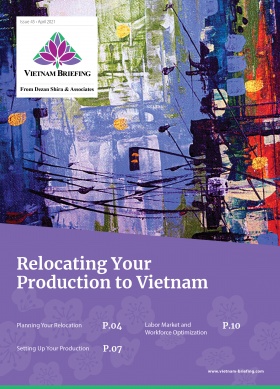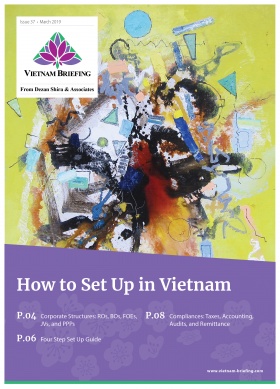Q&A: How to Set Up a Factory in Vietnam: From Location to Compliance
The manufacturing and processing sector is the most popular industry in Vietnam for foreign direct investment (FDI) – making up roughly 48 percent of registered capital. One of the few countries to show net positive GDP growth in 2020, Vietnam’s gain was driven largely by industrial action – which expanded 3.3 percent.
With strong government support of the sector, this trend is unlikely to change anytime soon.
Many foreign investors looking into Vietnam may be overwhelmed when considering available options. In a recent webinar, Dustin Daugherty, Head of North American Business Development for Dezan Shira & Associates, broke down the regions of Vietnam and addressed their strengths and weaknesses from a manufacturing perspective. Vietnam Briefing gleaned highlights from the webinar in a Q&A below, however, the full webinar can be viewed here.
What is the process of choosing a location?
Vietnam is a diverse country. The typical process to look for a new location involves a market study, initial screening, preliminary due diligence followed by a long list of locations, detailed due diligence, a comparison model development, final site selections, and if possible, a site visit.
Then there are different factors to evaluate potential locations. This includes the availability of materials, government policy, taxation, proximity to market, labor availability, incentives, infrastructure, local laws, and political stability. As mentioned earlier there is no one size that fits all. Each industry, market, and location is different. A tailor-made approach is essential. Businesses should build out a location by location comparative matrix to see which locations best suit their needs.
Can you describe the different regions?
Vietnam is diverse and investors should consider the strengths and weaknesses of each region when considering their investment. We will look at three district regions – the North, Center, and the South and give a high-level overview.
In the North – the capital Hanoi is the center of gravity, but the neighboring provinces are popular as well for manufacturing. The advantage of this region is its proximity to China and is therefore well-positioned for China plus one manufacturers. While electronics are prominent, there are several other industries such as automobiles, IT, and consumer goods that present a diverse economy. The labor availability in the Hanoi to Hai Phong metro area is abundant with a young labor structure. These are concentrated in industry clusters such as Hanoi, Bac Ninh, Bac Giang, and Hai Phong. Labor costs are relatively high in Hanoi and Bac Ninh due to the higher living standards.
In the Center – the region’s largest city is Da Nang, which has benefitted from good urban planning and development. The city is also popular among expats due to its good living environment and pristine beaches. The region is a low-cost destination as the North and South have become saturated with investment, driving up costs with congested logistic networks. However, industrial land is going up in Da Nang as it attracts more investment, especially from IT firms. The region’s labor force is young and dynamic and benefits from quality educational institutions. Traditional courses predominantly focus on science, engineering, IT, and economics. Some businesses may find it difficult to hire and retain hi-tech workers and senior managers. Average wages are around US$425 a month. There is a lot of value add it but can be challenging in other ways as the region has a less developed supply chain and does not have the economic gravity of the South.
The South is a diverse economic center of the country with a variety in FDI. Ho Chi Minh City is the economic hub of the country and has a flourishing middle class with increasing consumption. The region’s labor pool is deep and diverse with fresh graduates contributing to the labor pool. At approximately 10.6 million, the labor force is the most abundant in Vietnam with a high share of migrant labor. Labor is concentrated in large cities and industrial clusters such as Ho Chi Minh City, Binh Duong, and Dong Nai. Professional services such as IT and hospitality are key labor pools that have seen significant growth in the last decade. Competition for labor and talent is high between employers, while turnover, particularly during and immediately following the initial hiring process can cause delays for companies seeking to initiate production.
What are some market entry options?
There are several market entry options for an investor. These are: rent an existing factory, rent land and build a factory, use of land use right (LUR) and build a factory, and use of LUR and use an existing factory.
Setting up a factory can take time and varies between two to four months or longer. Some specifics to keep in mind when undertaking the process are: a construction permit, fire protection/safety, sector-specific licenses, public announcements, and an environmental impact assessment. Vietnam has several industrial parks which can take care of this process for you, however, investors are advised to have these reviewed by a third party.
Investors should also keep in mind the factory setup process such as acquiring an investment registration certificate (IRC), the enterprise registration certificate (ERC) also known as the business license, and doubles up as a tax registration number, and post-licensing procedures.
Finally, what are some practical steps investors can take?
Investors should ask themselves, if they can use sourcing/contract manufacturing or if they need their own facility. If they do need their own facility – does it make sense to go greenfield or acquire an existing facility. If they go greenfield, do they want to build to suit and lease or build to suit and buy. Building a facility can take time with challenges, whereas using contact manufacturing can be quicker with access to suppliers and partners.
It’s important to do your homework, especially regarding regional variations. We advise meeting with multiple industrial zones as they can vary in quality and incentives.
A comparative matrix assessing localized data points should include labor, land cost, supply chain depth, infrastructure quality, cost of utilities as well as tax and non-financial incentives though this is hardly exhaustive.
Lastly, be ready to negotiate with industrial parks and have a third party or professional firm review their work, as there have been instances where investors ran into trouble with government authorities due to inadequate licenses and procedures.
About Us
Vietnam Briefing is produced by Dezan Shira & Associates. The firm assists foreign investors throughout Asia from offices across the world, including in Hanoi, Ho Chi Minh City, and Da Nang. Readers may write to vietnam@dezshira.com for more support on doing business in Vietnam.
We also maintain offices or have alliance partners assisting foreign investors in Indonesia, India, Singapore, The Philippines, Malaysia, Thailand, Italy, Germany, and the United States, in addition to practices in Bangladesh and Russia.
- Previous Article Investing in Ben Tre Province: What Investors Need to Know
- Next Article Cross-Border Advertising Services in Vietnam: Decree 70







